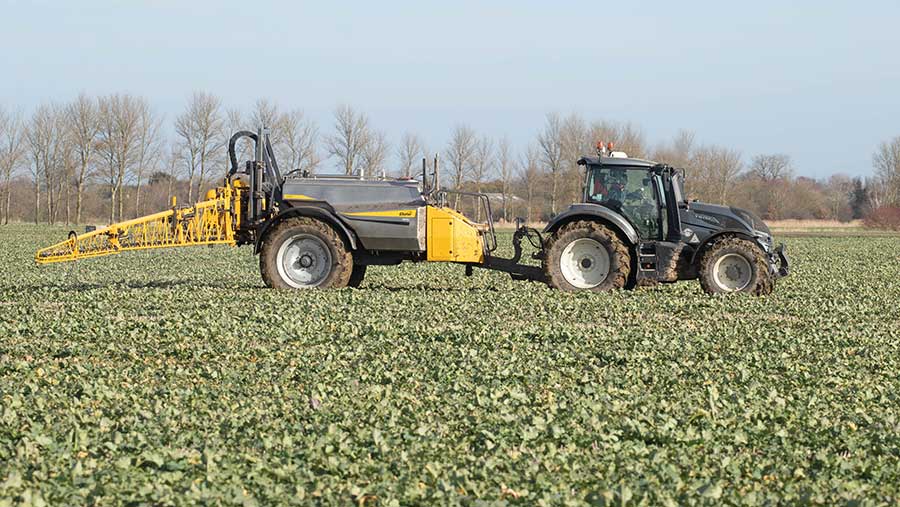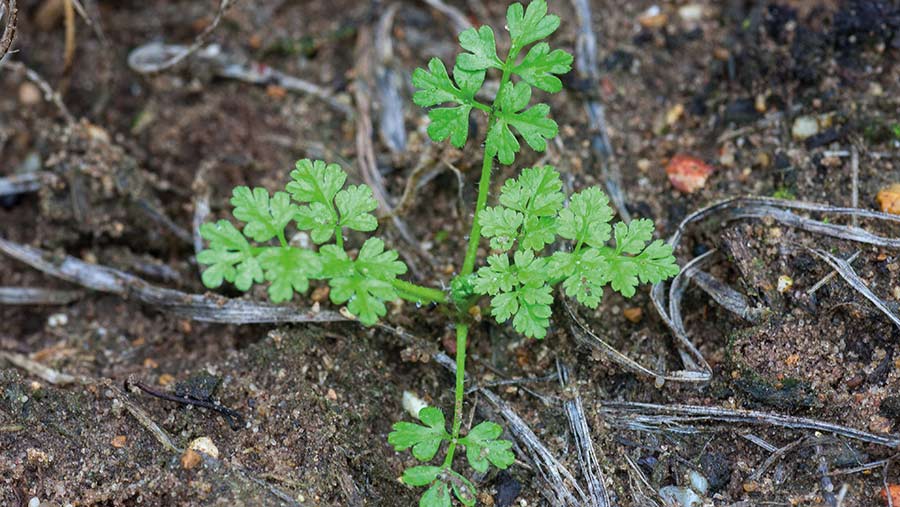Crop Watch: Early thoughts on disease and fertiliser strategies
 © Tim Scrivener
© Tim Scrivener After a mild autumn and winter, crops are looking lush and early thoughts turn to disease control and fertiliser strategies.
Growth regulation will also be important, as strong prices mean flat crops could prove even more costly at harvest.
West: Giles Simpson
Pearce Seeds (Somerset)
What a pleasant change to start the spring Crop Watch series with plenty of crops in the ground, looking generally well.
We are in a much better position this year compared with the past two springs. We can only hope it lasts.
See also: Direct-drilling wheat into clover ley saves farm £100/ha
The season has been kind so far in terms of the weather, with higher-than-average temperatures and lower-than-average rainfall in December and January.
There were some very big crops of OSR that have now been decimated by the pigeons.
I don’t think this is a problem, as they will have got rid of quite a lot of damaged, diseased leaves. With warmer and longer days these crops will recover and then flourish.
Many of the cereal crops have come through the winter very well, and there are some really big forward crops of both wheat and barley. But there is a lot of disease around, with many barley crops covered in mildew and net blotch.
Most barley crops are in need of nitrogen and manganese, although the lucky ones have either done one or both.
Hopefully, after a few more dry days, the heavier ground crops will receive an application of both.
Winter wheat crops have also done well, but have plenty of septoria present.
Fertiliser
The fertiliser applications for each crop will definitely have a lot of thought put into them considering many factors.
The main one is the availability of nitrogen, as some growers don’t have enough to cover all their cropping.
I would really encourage everybody to get up to date with their soil sampling and do soil mineral nitrogen testing to help build a crop nutrient plan.
With fertiliser prices so high and many farms in the South West having slurry or farmyard manure available, make sure these are tested as well to give an accurate analysis.
And when applying any organic manure, ensure you have an accurate record of how much was spread and where. If you don’t, you are just wasting a valuable asset.
Spring drilling has started on the lighter, drier ground and the seed-beds are very good; the heavier, wetter land is a little away from being ready yet.
North: Patrick Stephenson
AICC (Yorkshire)
Despite all the words and wisdom of our betters, we drill early in the North, fearing deluges and biblical weather.
This, of course, does happen – but not always.
A mild autumn and winter have seen the early-drilled crops achieve a staggering size and thickness. This has led to more than the odd crop having a sheep or two on it.
This winter has seen the rare combination of dry and mild weather, despite February trying to break the mould with a hefty 70mm of rainfall and the winds of storms Dudley, Eunice and Franklin.
This very kind weather is certainly going to make for a challenging season and I fear this one will be a rollercoaster with many twists and turns.
Winter wheats look well and, despite the recent battering, are full of promise. Blackgrass control overall has been good and there is only a minimum area that will require destroying.
Bur chervil and groundsel are the weeds that our autumn barrage is weak at controlling.
With forward, thick crops, my thoughts immediately turn to growth regulation. I don’t want to bleat about product availability, but exactly what we use will depend on what is available.
The programme will certainly be robust, as Vladimir Putin’s actions in Ukraine increase market volatility and the potential for £300/t wheat means flat wheat could be very costly!
There is plenty of septoria in crops, but I refuse to get excited. However, what will drag me from my calm state is the arrival of yellow rust, which I am sure is already present in several crops.
Early nitrogen is due, but this is being driven by the need to get the sulphur on, rather than the crop requiring it.
Lush barley
Winter barley crops, which I would normally regard as Cinderella crops at this time of the year, look green and very lush.
The main yield-building time for winter barleys is March to mid-April, and these will get priority for fertiliser, growth regulation and the first fungicide.
Many crops had very high mildew infestations before Christmas, but the magic of Mother Nature has certainly stopped this epidemic.
More of a challenge are grassweeds in winter barley. If control is poor with pre-emergence sprays, there are very few options and a redrill may be necessary.
Winter OSR crops are like palm trees and the whole season will be a voyage of exploration with growth and canopy manipulation.
With the potential for rape to earn £700/t, cutting nitrogen will be a balancing act, as modest yield increases will pay, even with N at £2/kg.
Light leaf spot is present, and the first growth regulator will have some protectant activity to keep on top of the disease.
Pigeons are active, but with huge canopies landing is a challenge, so grazing is more localised.
Winter beans look marvellous, and with commodity prices moving, surely we can expect a reasonable price for beans?
The only downside is that far too many have germinated and this leads to a scrap for light, and tall beans are not fun.
Post-emergence weed control in beans is best summed up as a wing and a prayer with bentazone.
My guide is: “Expect the worst and then you won’t be disappointed.”
This is not the place for political comment, but my thoughts and prayers go out to the people of Ukraine.
South: Oliver Bennetts
Zantra (Kent)
With the winter seeming yet to arrive here in the South East, my days walking fields have never felt especially cold.
With very few frosts and daytime temperatures having sometimes reached the low teens in January, as well as low rainfall, dry soils have allowed farmers to start drilling spring crops early or continue with some late winter wheat – until storm Eunice hit, temporarily halting well-laid plans.
The mild start to the year has allowed the development of diseases such as powdery mildew, septoria and yellow rust, which are easily found in cereals.
They were also seen last year, but the cold weather in April stopped them in their tracks.
The continued mild weather brings an additional concern for me – aphids carrying barley yellow dwarf virus could potentially make a move for cereal crops locally.
As well as a start to drilling, there have been a few early applications of nitrogen to cereal crops and first applications for oilseed rape.
Soil nitrogen
I have taken a lot of nitrogen cores over the past month and results indicate an increase in soil N compared with recent years.
This could be due to reduced rainfall, with 240mm falling from October to February, compared to 450mm in the same period in the previous two years.
This soil nitrogen levels will be good news for some, given the steep rise in fertiliser prices, allowing a slightly lower N application rate to crops this spring.
Unsurprisingly, oilseed rape has come through the winter well and has continued to progress slowly though the growth stages, with green buds starting to be seen.
New growth also shows minimal cabbage stem flea beetle larvae and little in the way of disease.
On the whole, crops are looking good and when the storms have passed, we will, hopefully, get stuck into the spring workload.
East: Marcus Mann
Frontier (Essex)
It has certainly been a pleasure to be walking fields without drudging through mud. This is reflected in crops, which are coming through the winter with good potential and showing little sign of anaerobic waterlogging.
A drier winter has also helped retain residual nitrogen, meaning cereals have been able to scavenge to prevent early nitrogen deficiency and tiller loss. Winter barley that has required early manganese applications is also a sign of a winter that has enabled good growing conditions.
Winter OSR has required early nitrogen to help support the barrage of pigeon damage.
Alongside early nitrogen to further encourage growth, applications of boron, manganese, molybdenum and magnesium will boost stem growth, chlorophyll production and nitrogen assimilation.
Due to a dry January, light leaf spot levels risk remain low in East Anglia and SpotCheck samples confirm this.
Larger crops, particularly those that were drilled early, may require a plant growth regulator at stem extension.
However, be sure to analyse the level of cabbage stem flea beetle larvae damage, as this may still stunt growth.
It is encouraging to see good grassweed control within the cereals, with residuals on the whole performing well.
Any blackgrass to survive is now fully tillering and probably beyond any form of control with contact herbicides. It is still worth noting, as the investment of rogueing these plants will provide good returns for future cropping.

© Blackthorn Arable
Weeds
Broad-leaved weeds, particularly the umbellifers such as bur chervil and shepherd’s needle, are present and becoming more of an issue.
It will be important to control these early, but be mindful if using a sulphonylurea, as they will require good growing conditions and warmer soils to gain control.
Surprisingly, disease pressure in cereals remains low.
Powdery mildew, rhynchosporium and brown rust are present in susceptible winter barley varieties and may need early treatment.
In winter wheat, active yellow rust isn’t apparent. But with few frosts, conditions are good for it to spread and it will be important to monitor.
Controlling yellow rust early in the programme with tebuconazole will be important, as existing chemistry suppresses rather than cures the disease.
Be mindful there are no approved tebuconazole products before growth stage 30.
Spring drilling will soon be well under way, with some already begun.
Spring beans in particular will benefit from early drilling however this does add extra pressure on broad-leaved weed control.
Do consider the broad-leaved weeds you require controlling when selecting herbicides.
For example, one weed that is becoming increasingly common is groundsel and the addition of prosulfocarb will further support control.

